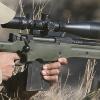"The only choice is 6PPC 62gr moving 3200-3400 no thing will shoot 100yds- 300yds better"
That's kind of getting to my question. Why wouldn't the 223 WSSM shoot better at the same bullet weight with a smaller diameter bullet at a higher speed?
I appreciate all the input everyone!
That's kind of getting to my question. Why wouldn't the 223 WSSM shoot better at the same bullet weight with a smaller diameter bullet at a higher speed?
I appreciate all the input everyone!


